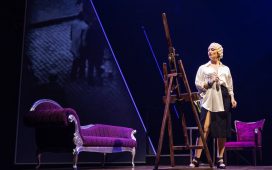White rabbits skitter here and there, disappearing abruptly through holes in the wainscot. Tiny theatres open out of outsize Victorian doors. Cunning checkerboard floors lead your mind and feet astray, while giant playing cards hurtle up the walls like flames up a chimney. And the Cheshire Cat’s fabled grin somehow hangs above it all like a crescent moon in mid-air: a fading glow in a midnight blue gallery.
Alice: Curiouser and Curiouser is a stupendous experience. It accomplishes three separate journeys in one – the story of how Lewis Carroll came to write Alice’s Adventures in Wonderland; the voyage of his startlingly original fiction of 1863 out into the world; and a tremendous recreation of Alice’s rabbit-hole adventures in the form of a labyrinthine show.
The visitor progresses through a sequence of stage sets, each centring on a particular character or event: the pool of Alice’s tears, raining down around you; the croquet game, in which you participate through virtual reality; the Mad Hatter’s tea party, laid with 20 crockery places that mysteriously morph from sinister black and white to a wild, flaring paisley. In between, passing among double mirrors, false corridors, psychedelic projections and doorways of all different sizes, you follow Alice’s influence on everything from theatre and cinema to maths and physics, from early music hall to Jefferson Airplane’s White Rabbit onwards.
Fashion shows its love of Alice, in Viktor & Rolf’s 2016 Victoriana collection, in the playing card costumes of the New Romantics, in Tim Walker’s magnificently outlandish Alice calendar for Pirelli in 2018, where black performers play all the characters and Alice (the Australian model Duckie Thot) literally grows too big for her platform boots.
Even cookery is involved – Alice is forever eating and drinking, as Freudian interpreters regularly note – with a film by the chef Heston Blumenthal attempting to make his own mock turtle soup over several days, the White Rabbit’s fob watch ultimately dissolving in a gilded consommé.
But it is the sheer singularity of Carroll’s story that stands out among all these ever-proliferating responses. Here is a child willing to follow a rabbit down a deep, dark hole out of pure curiosity, to withstand insults, riddles, dangerous confusions, near-drowning, possible poisoning and even the threat of execution. A pioneering Victorian, like her creator, she encounters the inexplicable, the imponderable and the unfamiliar with dauntless courage, ever the defiant adventurer.
How Alice grew into Alice, so to speak, is enthrallingly told. The show opens with son et lumière: a pool of dappled summer light and the sound of gentle oars, as the Oxford mathematician Charles Lutwidge Dodgson (AKA Carroll) rows 10-year-old Alice Liddell and her sisters along the River Isis, making up the story as they go. And there, quite suddenly, is the little notebook in which he wrote it all down for her – complete with a small sketch of the fictionalised Alice.

Carroll’s Alice draws on the longhaired maidens in Arthur Hughes’s pre-Raphaelite paintings: and here is the very picture that hung in Carroll’s study. His Ugly Duchess, with her muckle jaw, porcine nose and weird space buns is based upon Quinten Massys’s An Old Woman; and here is that 1513 masterpiece too. Carroll eventually hired the political cartoonist John Tenniel to illustrate the story, with his incisive graphic force, and thus the characters became synonymous with their portraits.
Alice’s blue dress, the Mad Hatter’s checked trousers, the Red Queen’s chess-piece crown: all are as proverbial as the characters themselves. And equally indelible are the flickering phrases projected here on objects and walls: “Why is a raven like a writing desk?” “People who don’t think shouldn’t talk.” “Who in the world am I?”
Carroll’s polymathic mind finds its emblem in a carousel of Victorian novelties: theodolite, kaleidoscope, daguerreotype, dodo. His heroine debates concepts about logic and language like a junior Wittgenstein. Matter, space and time are all explored as the rabbit tries to catch up with himself and Alice alternately shrinks and grows. A film by the German artist Mariele Neudecker centres on the so-called Alice experiment at Cern, where the tiniest particles in the universe are studied with the largest machines.

That Carroll’s story entered the global imagination is everywhere apparent, from Jan Švankmejer’s Czech puppetry to Walt Disney’s animation. More surprising is Alice’s political impact. A photograph shows South African women protesting against the corruption of Jacob Zuma. Their poster, referring to the Red Queen, reads: “If Alice could do it, so could we! Down with the bloody big head.”
The real Alice appears throughout in photographs, with her brown bob and unflinching stare, posing as Pomona for Julia Margaret Cameron and later snapped by Hollywood paparazzi when she visited the studios in 1932. Grinning at the cameras, with all her spry intelligence, she declares that cinema is now the only fit medium for Carroll’s ideas.
And somehow, in this image, she really does seem like the fictional Alice grown up – the same Alice who defies the bloodthirsty queen and the mad raging duchess, who really could have stood up to Jacob Zuma. The same heroine who finally gathers all her courage during the climactic court confrontation with the Queen of Hearts and declares what is, after all, the whole truth: “You’re nothing but a pack of cards!”
-
Alice: Curiouser and Curiouser is at the V&A, London, until 31 December








